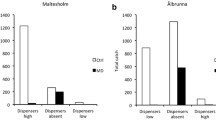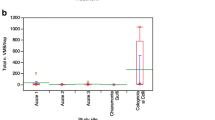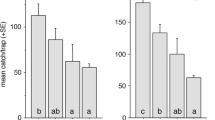Abstract
The spatial distribution of the pheromone of the grape vine moth.Lobesia botrana (Lepidoptera: Tortricidae), was measured in vineyards treated for mating disruption by using an electroantennogram technique (EAG). Five hundred dispensers per hectare, each containing 0.1 g of the main component of the sex pheromone (E,Z)-7,9-dodecadienyl acetate (E7,Z9-12: Ac) were evenly distributed in the experimental vineyards. The EAG amplitudes measured in the experimental plots were transformed into relative pheromone concentrations by means of a calibration curve. Mean relative pheromone concentrations in the center of a treated plot reached 2.31 × 10−4 relative units. No significant differences in the mean relative pheromone concentrations were found between replicate plots (P > 0.01). The mean relative pheromone concentrations measured within one plot along a transect at 5-m intervals also showed no significant differences between the sites. These results indicate that inside the borders of treated areas the pheromone was evenly distributed. No sites with significantly lower pheromone concentrations, frequently assumed to be the cause for higher trap catches in some areas, were found. However, the mean relative pheromone concentration rapidly declined more than 100-fold outside the border of the treated plot. At 10 m from the treated area, the EAGs showed no significant difference compared to the EAGs recorded in an untreated area. A rapid drop in the mean relative pheromone concentration was also found on a vertical transect through the canopy of the vineyard. Measurements in an untreated control block gave a mean antennal response approximately 1000-fold lower than in a nearby pheromone treated plot. The significance of the variation in the pheromone distribution for the success of the mating-disruption method is discussed.
Similar content being viewed by others
References
Arn, H., Rauscher, S., andSchmid, A. 1979. Sex attractant formulations and traps for the grape vine mothEupocilia ambiguella Hb.Mitt. Schweiz. Entomol. Ges. 52:49–55.
Baker, T.C., andHaynes, K.F. 1989. Field and laboratory electroantennographic measurements of pheromone plume structure correlated with oriental fruit moth behavior.Physiol. Entomol. 14:1–12.
Bartell, R.J. 1982. Mechanisms of communication disruption by pheromone in control of Lepidoptera: A review.Physiol. Entomol. 7:353–364.
Bengtsson, M., Karg, G., Kirsch, J., Löfqvist, J., Sauer, A.E., andWitzgall, P. 1994. Mating disruption of the pea mothCydia nigricana F. (Lepidoptera, Tortricidae) with a repellent blend of sex pheromone and attraction inhibitors.J. Chem. Ecol. 20:871–887.
Buser, H.-R., Rauscher, S., andArn, H. 1974. Sex pheromone ofLobesia botrana: (E,Z)-7,9-Dodecadienyl acetate in the female grape vine moth.Z. Naturforsch. 29c:781–783.
Carde, R.T. 1990. Principles of mating disruption, pp. 22–71,in R.L. Ridgeway, R.M. Silverstein, and M.N. Inscoe (eds.). Behavior-Modifying Chemicals for Insect Management. Marcel Dekker, New York.
Caro J.H., Glodfelty, D.E., andFreeman, H.P. 1980. (Z)-9-Tetradecen-1-ol formate. Distribution and persistence in the air within a corn crop after emission from a controlled-release formulations.J. Chem. Ecol. 6:229–236.
Caro, J.H., Freeman, H.P., Brower, D.L., andBierl-Leonhardt, B.A. 1981. Comparative distribution and persistence of dispalure in woodland after areal application of three controlled-release formulations.J. Chem. Ecol. 7:501–508.
Charmillot, P.-J., andVickers, R.A. 1991. The use of sex pheromones for control of tortricid pests in pome and stone fruits, pp. 487–496,in L.P.S. van der Geest and H.H. Evenhuis (eds). Tortricid Pests, Their Biology, Natural Enemies and Control, World Crop Pest Volume 5 Elsevier, Amsterdam.
Jutsum, A.R., andGordon, R.F.S. (eds.) 1989. Insect Pheromones in Plant Protection. Wiley, New York.
Karg, G., andSauer, A. 1992. Structure of the odour plume in a vineyard treated for mating disruption of the grape vine mothLobesia botrana, pp. 296–297,in S.A. Corey, D.J. Dall, and W.M. Milne, (eds.). Pest Control and Sustainable Agriculture,Proceedings of the Fifth Australian Applied Entomological Research Conference, April 27-May 1, Canberra, ACT, Australia.
Karg, G., Sauer, A.E., andKoch, U.T. 1990a. Effects of the odor source distribution on the odor plume structure, p. 41,in Abstracts IX ECRO Symposium, Nordwijkerhout, The Netherlands, September 2–7, 1990.
Karg, G., Sauer, A.E., andKoch, U.T. 1990b. The influence of plants on the development of pheromone atmospheres measured by EAG method, p. 301,in N. Elsner, and G. Roth (eds.). Brain-Perception-Cognition. Proceedings of the 18th Göttingen Neurobiology Conference. Thieme Verlag, Stuttgart.
Karg, G., Suckling, D.M., andBradley, J.S. 1994. Absorption and release of pheromone ofEpiphyas postvittana (Lepidoptera: Tortcidae) by apple leaves.J. Chem. Ecol. 20:1825–1841.
Netter, H. 1993. Untersuchungen zur Biologie und zum Verhalten vonLobesia botrana (Den. & Schiff.) zur Entwicklung einer Bekämpfung mittels Pheromonen. Dissertation, University of Kaiserslautern.
Ridgeway, R.L., Silverstein, R.M., andInscoe, M.N. 1990. Behavior-Modifying Chemicals for Insect Management: Application of Pheromones and Other Attractants. Marcel Dekker, New York, 761 pp.
Rothschild, G.H.L. 1981. Mating disruption of lepidopterous pests: Current status and future prospects, pp. 207–228,in E.R. Mitchel (ed.). Management of Insect Pests with Semiochemicals. Plenum Press, New York.
Rumbo, E.R. 1981. Study of single sensillum responses to pheromone in the light brown apple moth,Epiphyas postvittana, using the averaging technique.Physiol. Entomol. 6:87–98.
Rumbo, E.R., Suckling, D.M., andKarg, G. 1995. Measurements of airborne pheromone concentrations using EAG equipment: Interaction between environmental volatiles and pheromones.J. Insect Physiol. 47:465–471.
Sanders, C.J. 1981. Disruption of spruce budworm mating—the state of the art, pp. 339–349,in E.R. Mitchel, (ed.). Management of Insect Pests with Semiochemicals. Plenum Press, New York.
Sauer, A.E., Karg, G., de Kramer, J.J., Milli, R., andKoch, U.T. 1992. A portable system for the measurement of pheromone concentrations in the field.Chem. Senses 17:543–588.
Schneikart, H. 1989. Freilandbeobachtungen zum Sexualverhalten des bekreuzten Traubenwicklers (Lobesia botrana Den. & Schiff.) in Zusammenhang mit der Verwirrungstechnik. Dissertation, University of Vienna.
Suckling, D.M. 1993. Sex pheromones: Are they delivering to expectations? pp. 62–65,in S.A. Corey, D.J. Dall, and W.M. Milne (eds.). Pest Control and Sustainable Agriculture. CSIRO, Canberra.
Suckling, D.M., andShaw, P.W. 1992. Conditions that favour mating disruption ofEpiphyas postvittana (Lepidoptera: Tortricidae)Environ.Entomol. 21:949–956.
Suckling, D.M., Karg, G., Bradley, S.J., andHoward, C.R. 1994. Field electroantennogram and behavioral responses ofEpiphyas postvittana (Lepidoptera: Tortricidae) under low pheromone and inhibitor concentrations.J. Econ. Entomol. 87:1477–1487.
Uchijiama, Z. 1988. Concentration and diffusion of pheromone in air. Japan Plant Protection Assoc., Symposium on Sex Pheromones, Tokyo, October 17–21, 1988.
van der Pers, J.N.C., andMinks, A.K. 1993. Pheromone monitoring in the field using single sensillum recordings.Entomol. Exp. Appl. 68:237–245.
Author information
Authors and Affiliations
Rights and permissions
About this article
Cite this article
Karg, G., Sauer, A.E. Spatial distribution of pheromone in vineyards treated for mating disruption of the grape vine mothLobesia botrana measured with electroantennograms. J Chem Ecol 21, 1299–1314 (1995). https://doi.org/10.1007/BF02027563
Received:
Accepted:
Issue Date:
DOI: https://doi.org/10.1007/BF02027563




